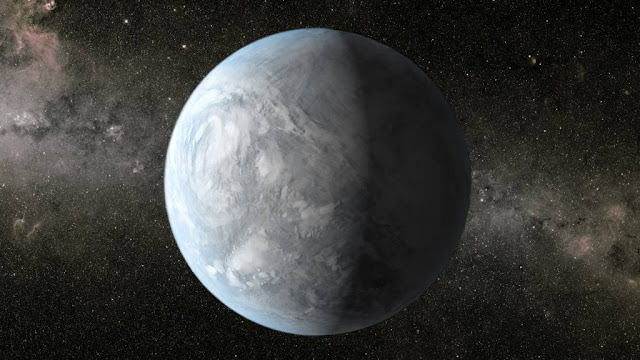An artist's conception of Kepler 62-e, a super-Earth exoplanet. Astronomers working to detect super-Earths around the most common kind of stars, M dwarfs, have successfully tested infrared techniques that overcome some of the limitations of optical measurements.
Credit: NASA/Kepler mission
The
search for exoplanets via the radial velocity technique has been
underway for nearly thirty years, measuring the wobbles in a star's
motion caused by the presence of orbiting bodies. The method has been
very successful and has detected hundreds of exoplanets, but has been
overtaken (at least in numbers of detections) by the transit method,
which looks for dips in the star's light. The radial velocity method has
some powerful advantages, however, most notably that it can spot
planets that do not pass across the face of the star ("transit"). The
majority of radial velocity targets (so far) have been stars similar
roughly to our Sun, but this neglects the majority of stars, the less
massive class M dwarfs, which make up 75% of the stars in the solar
neighborhood. Surveys of some nearby M dwarfs have been able to reach
astonishing velocity precisions - as tiny as a few meters per second
(4.5 miles per hour) -- adequate to detect a super-Earth orbiting in the
star’s habitable zone (where surface water remains liquid). In order to
detect an Earth-mass planet around a solar-type star, however,
precisions twenty times better are needed.
One of the technical challenges in measuring radial velocities for
M-dwarfs is that they are relatively faint in the optical. Near
infrared techniques can ameliorate this issue because the stars are
brighter in the infrared, but naturally face some other problems. CfA
astronomers John Johnson and Dave Latham were part of a team of
scientists working to advance infrared techniques for radial velocity
studies of M-dwarfs. Using the current infrared instruments on NASA’s
Infrared Telescope Facility in Hawaii, the astronomers were able to
achieve about three meters per second precision on some test M stars,
demonstrating that the technique and the methods used to process and
analyze the data are reliable. There are next generation infrared
instruments are in the pipeline, and the new paper demonstrates that
they should be able to spot super-Earths and mini-Neptunes in the
habitable zones of M dwarfs.
Reference(s):
"Retrieval
of Precise Radial Velocities from Near-infrared High-resolution Spectra
of Low-mass Stars," Peter Gao, Plavchan P., Gagné J, Furlan E., Bottom
M., Anglada-Escudé G., White R., Davison C. L., Beichman C., Brinkworth
C., Johnson J., Ciardi D., Wallace K., Mennesson B., von Braun K.,
Vasisht G., Prato L., Kane S. R., Tanner A., Crawford T. J., Latham D.,
Rougeot R., Geneser C. S., and Catanzarite J., PASP 128, 104, 2016.
